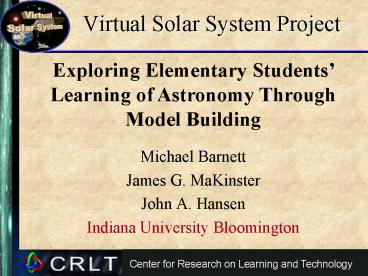Virtual Solar System Project - PowerPoint PPT Presentation
1 / 18
Title:
Virtual Solar System Project
Description:
Exploring Elementary Students' Learning of Astronomy Through Model Building ... Students used their model as a tool to learn about astronomy and test their own ideas ... – PowerPoint PPT presentation
Number of Views:27
Avg rating:3.0/5.0
Title: Virtual Solar System Project
1
Virtual Solar System Project
Exploring Elementary Students Learning of
Astronomy Through Model Building
- Michael Barnett
- James G. MaKinster
- John A. Hansen
- Indiana University Bloomington
Center for Research on Learning and Technology
2
Need for VSS course
- Computational Modeling Emergence
- The scientific process has been described as the
process of constructing models for their
predictive and conceptual value. (Gilbert, 1991)
- Computer models engage students (Stratford, 1996)
- Scientific models are used to argue points of
public interest
3
Astronomy Learning
- Students have intrinsic interest in astronomy
- Students have a number of alternative conceptions
(Sneider Ohadi, 1998) - Students have a difficult time learning astronomy
concepts (e.g. Barnett Morran, in press) - Challenge of understanding relationships between
objects (Earth, Moon, etc)
4
Research Questions
- When students engage in modeling activities, what
kinds of models can they really construct? - Does modeling support students in asking
meaningful questions? - What processes do students actually go through
when constructing computer models?
5
VSS Course Design
- Project-based (Blumenfeld, et al., 1991)
- Collaborative groups
- Constructing models of the Earth-Moon-Sun System
- Engage in inquiry process
- Students develop and answer their own questions
about the solar system - Originally designed for undergraduate astronomy
courses
6
Enabling Technology
- Students construct computer models using Virtual
Reality software - Students can post their models on the WWW
- Motivational element
- Students are able to shift their viewpoint from
one object to another - Look at Earth from Moons perspective
7
VRML modeling software
8
Student Model
9
Study Context
- 5th grade elementary class
- Rural elementary school
- Length of unit
- Three weeks
- Three days a week
- 50 minutes per class period
- 12 students
- Worked in groups of three
10
Study Methods
- Participant Observation
- Interviewed one student from every group at the
end of every class - Each group was videotaped
- Used videos, interviews, and researchers notes to
construct cases of each group
11
Results General Findings
- Students constructed sophisticated models of the
Earth-Moon-Sun system - Demonstrated eclipses, phases of the Moon, and
different perspectives - Students started simple and gradually added
complexity - Allowed for detailed exploration of specific
aspects of the Earth-Moon-Sun system
12
Results Case of the Stargazers
- Students had difficulty in critically examining
their model - Students simply put objects in their model
- Students did not scale their Sun
- Matt Ok, lets put in a Sun!
- John Where at?
- Jerry Lets put it over there. (pointing to a
place on the screen to the left of their
Earth)
13
Results Case of the Stargazers
- Students used their model as a tool to learn
about astronomy and test their own ideas - Designing their model supported students in
meaningful discussions - John (running their model), Ok what do we want
to do? - Jerry Lets go to the Moon!
- John Ok (changes his viewpoint to be on the
Moon). - Matt Whoa! Look at the Earth?
- Jerry Hey! It has phases. Look it is getting
dark. - Matt Yea, I bet if we wait it will be bright
again, just like the Moon. - Jerry What if we had a camera on the other side
of the Moon? - Matt I dont know lets put one.
14
Results Case of the Stargazers
- Students superficially examined their models at
times - Instructor was crucial in pushing students to
critically examine their models - As time progressed, students used previous
discussions to inform the design of their model
15
Results Case of the Stargazers
- Computer modeling sparked discussion that led to
additional exploration of astronomical phenomena - Matt Whoa! Look at the Earth!
- Jerry Hey! It has phases, Look it is getting
dark. - Matt Yea, I bet if we wait it will be bright
again, just like the Moon. - Jerry What if we had a camera on the other side
of the Moon? - Matt I dont know lets put one.
16
Discussion
- 5th grade students were able construct
sophisticated models - Students needed significant guidance early in the
model construction process - Students moved from learning about their model to
learning with their models - Students engaged in an iterative modeling process
17
Future Work and Remaining Questions
- Does model construction facilitate conceptual
change? - Examine student pre-post interviews
- Construct cases for the other student groups
- Cross case analysis to further understand
students model construction process - What is gained and lost by having students use
pre-built models as opposed to having them
construct models?
18
More Information
- For papers and presentations
- http//inkido.indiana.edu/presentations/aera2001/
- For more about Virtual Solar System Project at
Indiana University - http//vss.crlt.indiana.edu/
- Contact person Michael Barnett
gmbarnet_at_indiana.edu































